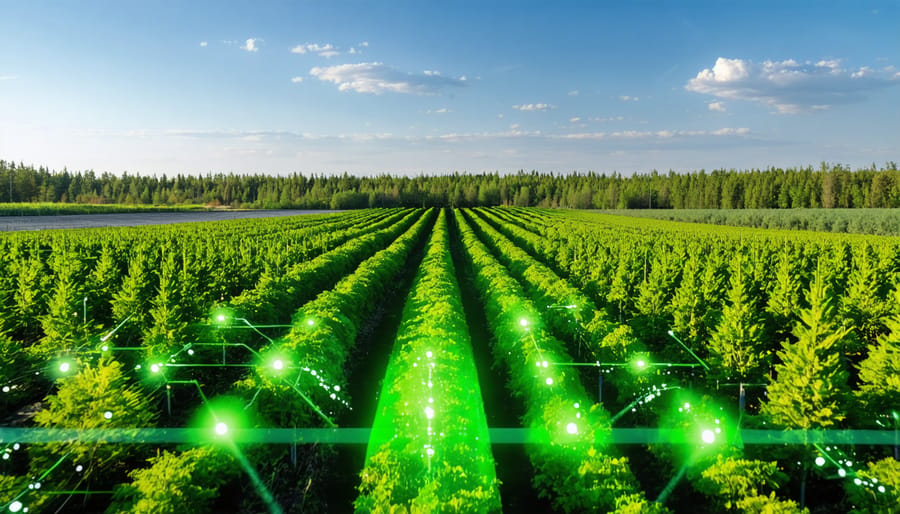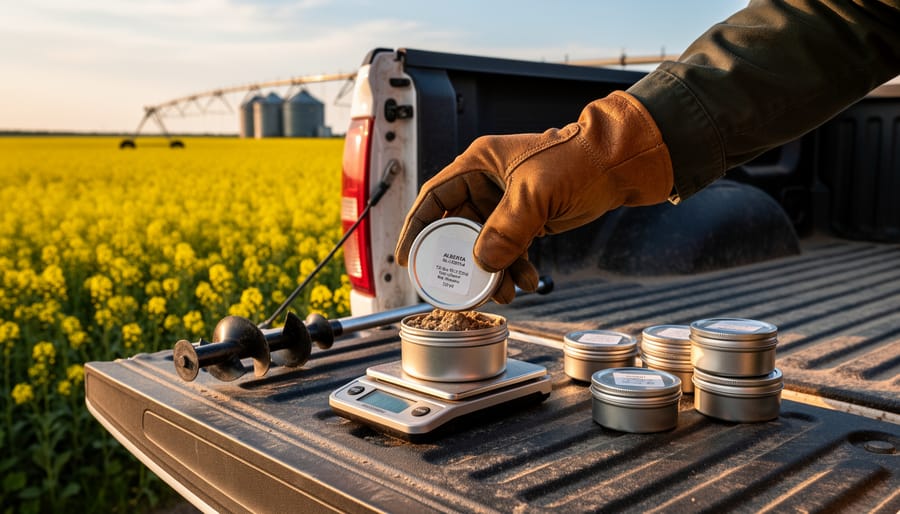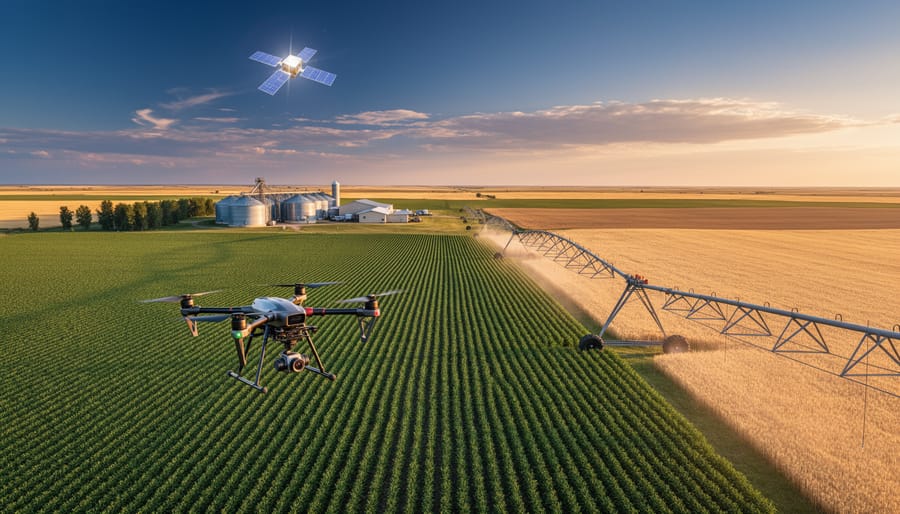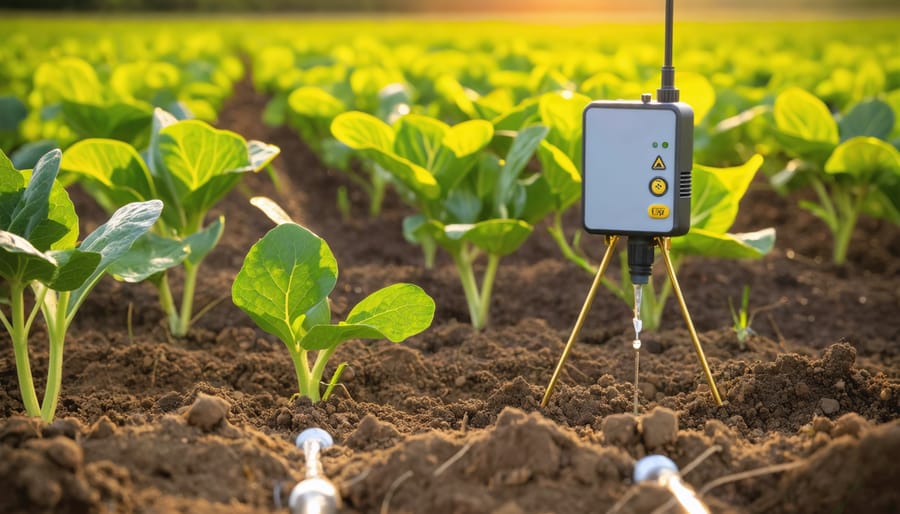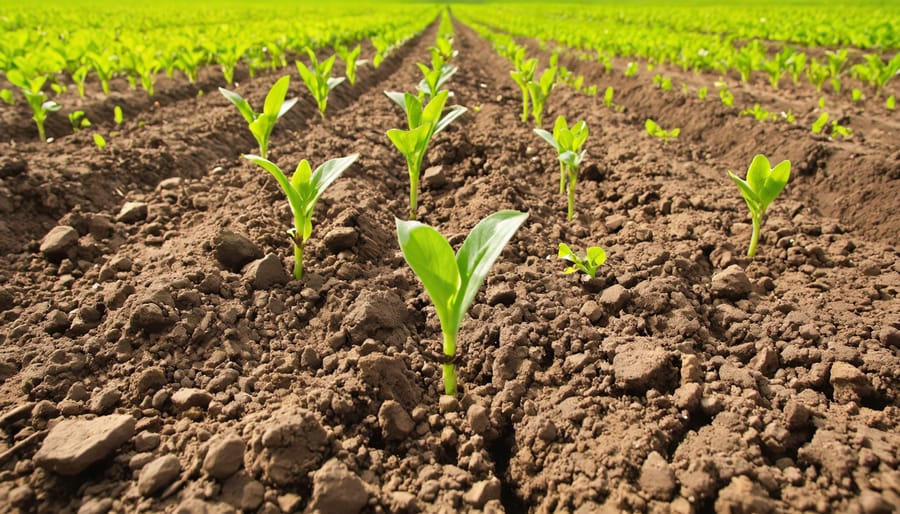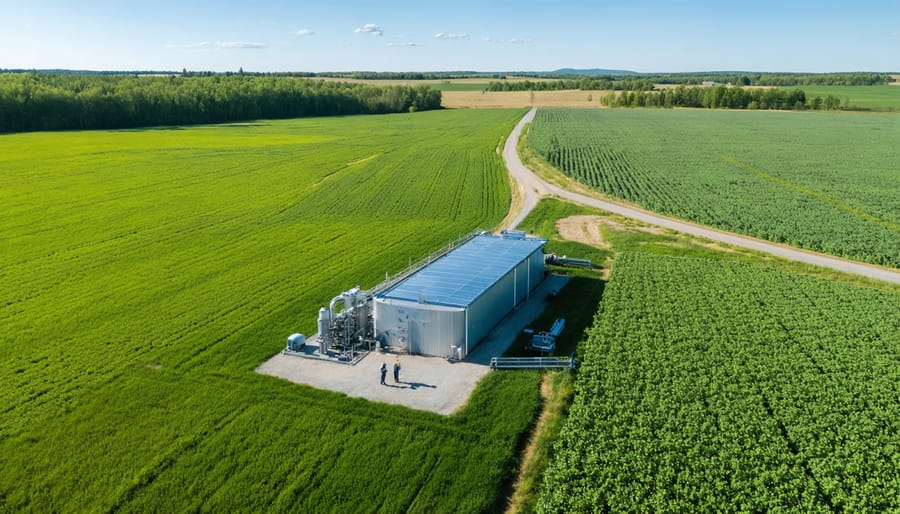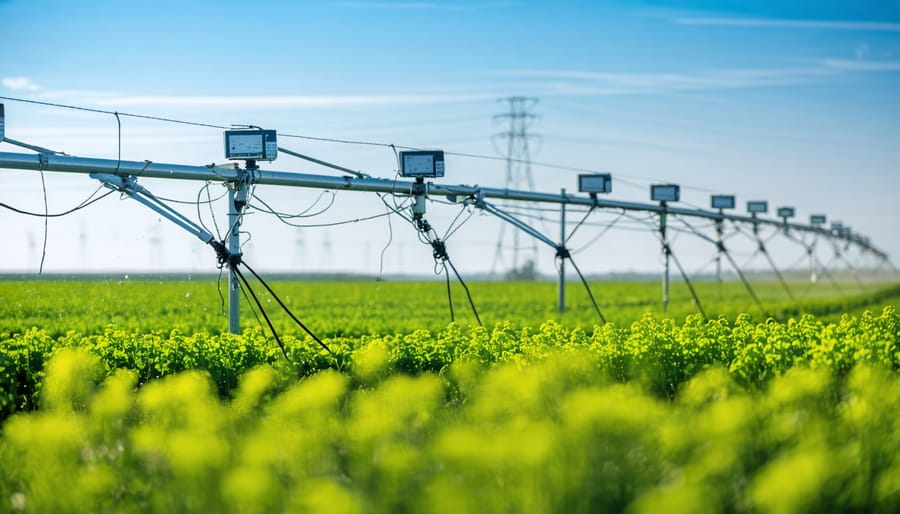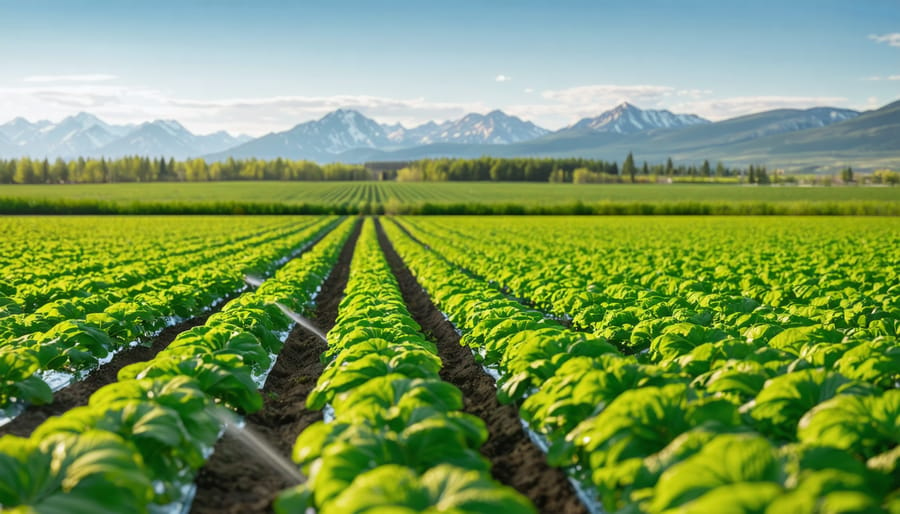Transform your tree farm’s productivity with smart irrigation solutions engineered specifically for Alberta’s unique climate patterns. Modern drip systems reduce water consumption by up to 40% while delivering precise moisture levels directly to root zones, maximizing seedling survival rates and accelerating growth cycles. Soil moisture sensors, strategically placed throughout growing zones, now enable real-time monitoring and automated adjustments, ensuring optimal water distribution across diverse species and growth stages. Leading Alberta tree farms implementing these systems report 30% faster establishment rates and significant labor cost reductions, particularly crucial during peak growing seasons. Combined with climate-smart scheduling and zone-specific programming, these advanced irrigation networks help local growers maintain consistent soil moisture levels despite challenging chinook conditions, while meeting stringent environmental compliance standards.
The Evolution of Tree Farm Irrigation in Alberta
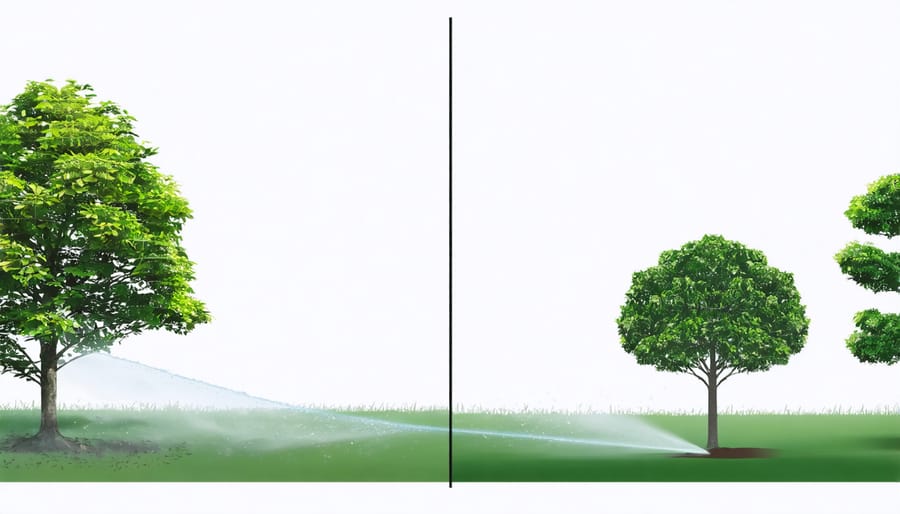
Climate Challenges and Water Conservation
Tree farmers in Alberta face unique challenges when it comes to water management and irrigation. Alberta’s climate challenges include highly variable precipitation patterns, with some regions receiving less than 350mm of annual rainfall, and others experiencing intense summer storms that can overwhelm traditional irrigation systems.
Our prairie climate brings hot, dry summers and cold winters, creating distinct seasonal demands for water management. During peak growing seasons, many areas experience high evaporation rates, which can quickly deplete soil moisture. This makes efficient irrigation crucial for tree farm success.
Water conservation isn’t just about managing scarcity – it’s about being responsible stewards of our resources. Many local farmers have found success by implementing soil moisture monitoring systems and weather-based irrigation controllers. These tools help maintain optimal soil conditions while reducing water waste.
The key is to understand your specific microclimate and soil conditions. What works for a tree farm near Calgary might need adjustment for operations in the Peace Country region. By monitoring local weather patterns and soil moisture levels, you can develop an irrigation strategy that’s both effective and sustainable.
Smart Technology Integration
Modern tree farms are embracing smart technology to revolutionize irrigation practices. These innovative systems combine sensors, automation, and data analytics to deliver precise water management solutions. Soil moisture sensors placed throughout the farm continuously monitor ground conditions, while weather stations track local climate patterns and rainfall. This data feeds into central control units that automatically adjust watering schedules and volumes.
Many Alberta farmers are now using smartphone apps to monitor and control their irrigation systems remotely. These apps provide real-time alerts about system performance, water usage, and potential issues. Some advanced systems even integrate satellite imagery and AI-powered analytics to create detailed irrigation maps and predict water needs based on tree species and growth stages.
Smart controllers can also connect with local weather forecasts to automatically skip irrigation cycles when rain is expected, helping conserve water and reduce operational costs. These systems typically pay for themselves within two to three growing seasons through reduced water consumption and improved crop health. For larger operations, drone technology is becoming increasingly popular for surveying irrigation coverage and identifying potential system inefficiencies or maintenance needs.
Core Components of Smart Tree Farm Irrigation
Soil Moisture Sensors and Weather Stations
Modern tree farms rely heavily on soil moisture sensors and weather stations to optimize irrigation scheduling and water usage. These monitoring systems provide real-time data about soil conditions, helping Alberta farmers make informed decisions about when and how much to irrigate.
Typical sensor installations include multiple probes placed at different depths, usually between 15 and 60 centimetres, to monitor moisture levels throughout the root zone. Weather stations complement these readings by tracking precipitation, temperature, wind speed, and humidity – all crucial factors in determining water requirements.
Many Alberta tree farmers report 25-30% water savings after implementing these monitoring systems. Local success stories include the Morrison Family Farm near Red Deer, which reduced their water consumption by 28% in their first season using smart monitoring equipment.
The data collected feeds directly into automated irrigation controllers or mobile apps, allowing farmers to adjust watering schedules remotely. This technology is particularly valuable during extreme weather events, which are becoming more common in our region. Regular monitoring also helps identify potential issues like soil compaction or drainage problems before they affect tree health.
For best results, sensors should be calibrated annually and placed in locations that represent the overall soil conditions of your tree farm. Consider working with local agricultural extension services for proper placement and interpretation of monitoring data.
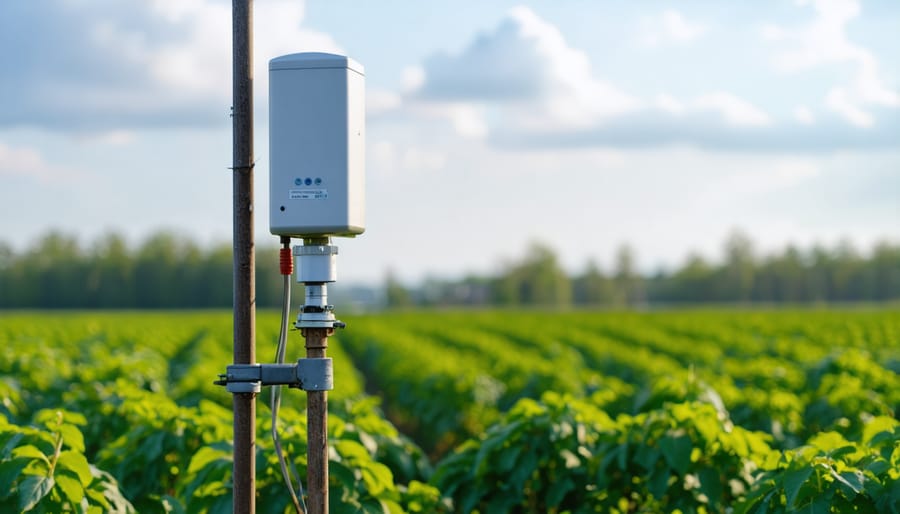
Automated Control Systems
Modern tree farms are increasingly turning to automated control systems to optimize irrigation efficiency and reduce water waste. Smart controllers use real-time data from soil moisture sensors, weather stations, and environmental monitors to make informed decisions about when and how much to water your trees.
These systems can be programmed to follow specific schedules based on tree species, growth stages, and seasonal requirements. Many Alberta farmers have found success with controllers that integrate local weather forecasts, automatically adjusting irrigation timing to avoid watering before predicted rainfall.
The scheduling software that powers these systems allows farmers to set different watering zones, accounting for variations in soil type, slope, and tree density across the farm. Mobile apps make it possible to monitor and adjust irrigation settings remotely, saving valuable time during busy seasons.
For example, the Thompson Family Tree Farm near Red Deer reduced their water consumption by 30% after implementing a smart control system that precisely tracks soil moisture levels and adjusts watering schedules accordingly. The initial investment in automation typically pays for itself through water savings and improved tree health within two to three growing seasons.
Precision Application Methods
Modern precision irrigation methods have revolutionized tree farm management across Alberta. Drip systems, consisting of polyethylene tubes with regularly spaced emitters, deliver water directly to the root zone of each tree. These systems typically operate at 1-4 litres per hour, ensuring consistent moisture without wastage.
Micro-sprinklers offer another targeted approach, providing a controlled spray pattern that covers the tree’s critical root zone. These sprinklers can be adjusted to deliver water in a 1-3 metre radius, perfect for both young saplings and mature trees. Many Alberta farmers report water savings of 30-40% compared to traditional irrigation methods.
Smart irrigation controllers enhance these systems by integrating local weather data and soil moisture sensors. For example, the Morgan Tree Farm in Red Deer uses soil probes that monitor moisture levels at different depths, automatically adjusting water delivery based on real-time conditions.
When choosing between drip systems and micro-sprinklers, consider your soil type and tree spacing. Sandy soils often benefit from more frequent, shorter watering cycles through drip systems, while clay soils may do better with micro-sprinklers’ broader distribution pattern.
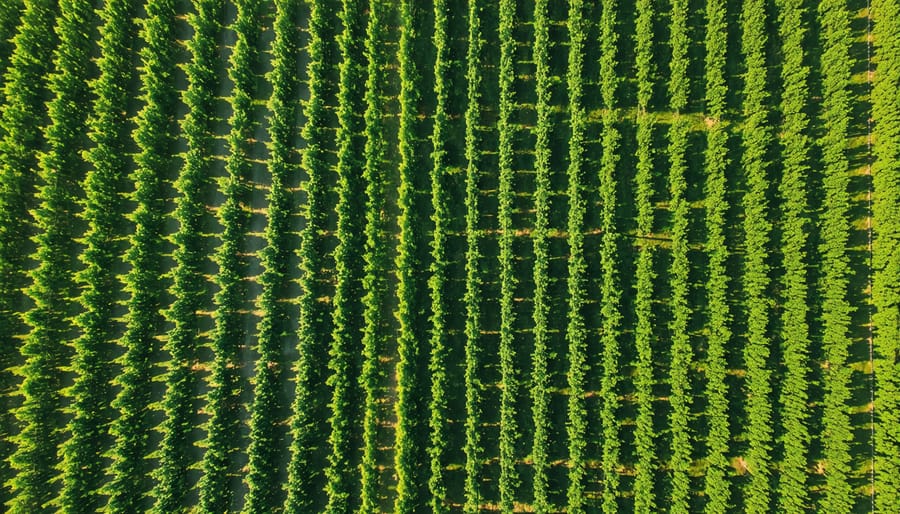
Implementation Success Story: Red Deer Valley Tree Farm
Located just outside of Red Deer, Alberta, the Red Deer Valley Tree Farm has become a shining example of successful smart irrigation implementation in the Canadian Prairies. Owner Sarah MacPherson, a third-generation farmer, transformed her 120-hectare operation from a traditional sprinkler system to a state-of-the-art smart irrigation setup in 2019, achieving remarkable results in water conservation and tree health.
“We were using nearly 40% more water than necessary with our old system,” MacPherson explains. “The change wasn’t just about saving water – it was about growing healthier trees and running a more sustainable operation.”
The farm, which specializes in growing native Canadian species like white spruce and lodgepole pine, installed a comprehensive system featuring soil moisture sensors, weather monitoring stations, and automated drip irrigation zones. The setup cost approximately $75,000, with 30% covered by provincial agricultural grants.
The results speak for themselves. Within the first growing season, the farm reduced water consumption by 35% while maintaining optimal soil moisture levels. Tree survival rates increased from 82% to 94%, and the time spent managing irrigation decreased by nearly 60%.
Key components of their success included:
– Installation of 250 soil moisture sensors across different soil types
– Implementation of automated weather monitoring
– Integration with local weather forecasting data
– Zone-specific irrigation scheduling
– Mobile monitoring and control capabilities
The system proved particularly valuable during the drought conditions of 2021. While neighbouring farms struggled, Red Deer Valley maintained healthy growth rates by precisely targeting water delivery based on real-time soil conditions and weather patterns.
“The return on investment has been faster than expected,” notes MacPherson. “Between water savings, reduced labour costs, and improved tree quality, we recovered our initial investment within two years.”
The farm now serves as a demonstration site for the Alberta Agricultural Society, hosting regular workshops for other tree farmers interested in smart irrigation technology. MacPherson emphasizes that success came from careful planning and a phased implementation approach, allowing staff to learn and adjust to the new system gradually.
The farm’s experience has also highlighted the importance of local expertise, as they worked closely with irrigation specialists familiar with Alberta’s unique climate conditions to optimize their system for the region’s specific challenges.
Cost-Benefit Analysis and Funding Options
Initial Investment vs Long-term Savings
Setting up a modern irrigation system for your tree farm requires careful financial planning, but the long-term benefits often outweigh the initial investment. A typical smart irrigation system for a 10-hectare tree farm in Alberta costs between $15,000 and $25,000 for installation, including sensors, controllers, and piping infrastructure.
While this upfront cost might seem substantial, farmers consistently report significant irrigation cost savings within the first two years of implementation. Most operations see a 30-40% reduction in water usage and a 25% decrease in energy costs, translating to approximately $3,000-$4,000 in annual savings.
The return on investment typically occurs within 4-6 years, depending on factors like tree species, local climate conditions, and energy costs. Additional benefits include reduced labour costs through automation and improved tree health, which can increase crop value by 15-20%.
Government grants and environmental incentives can help offset initial costs. The Canadian Agricultural Partnership currently offers funding covering up to 30% of irrigation system improvements for eligible farmers. Local conservation authorities may provide additional rebates for water-efficient farming practices, making the investment more manageable for small to medium-sized operations.
Alberta Agricultural Grants and Resources
Alberta farmers looking to implement or upgrade irrigation systems on their tree farms have access to several valuable funding opportunities. The Canadian Agricultural Partnership (CAP) offers grants of up to $500,000 for irrigation infrastructure improvements, focusing on water-efficient technologies and sustainable practices.
The Environmental Stewardship and Climate Change Producer Program provides cost-sharing opportunities of up to 70% for projects that enhance water management and promote environmental sustainability. Tree farm operators can apply for funding to install soil moisture sensors, weather stations, and automated irrigation controls.
The Agriculture Financial Services Corporation (AFSC) offers low-interest loans specifically designed for irrigation equipment purchases and system upgrades. These loans feature flexible repayment terms and competitive rates for qualified agricultural producers.
Additionally, the Irrigation Efficiency Program, administered by Alberta Agriculture and Forestry, provides technical support and funding for irrigation system assessments. This program helps farmers optimize their water usage through professional consultations and equipment modernization.
Local irrigation districts often provide matching grants for system improvements that demonstrate water conservation. The Alberta Irrigation Technology Centre offers free workshops and demonstrations of modern irrigation techniques throughout the growing season.
For application assistance and guidance, farmers can connect with regional agricultural fieldmen or visit their nearest Agriculture Service Board office. Regular grant-writing workshops are available through Alberta Agriculture’s knowledge network.
As we’ve explored throughout this article, smart irrigation systems represent a game-changing investment for tree farm operations across Alberta. These systems not only optimize water usage, potentially reducing consumption by 30-40%, but also contribute significantly to healthier tree growth and improved farm productivity.
The benefits extend far beyond water conservation. From labour savings and reduced operational costs to precise nutrient delivery and decreased disease pressure, smart irrigation systems are helping Canadian farmers stay competitive while maintaining their commitment to environmental stewardship. Many Alberta tree farmers report seeing returns on their investment within 2-3 growing seasons, particularly through reduced input costs and improved tree quality.
Looking ahead, the adoption of smart irrigation technology will become increasingly important as we face changing climate patterns and growing pressure on water resources. The good news is that government support, including grants and technical assistance, is available to help farmers make this transition. Local agricultural extension services and farming cooperatives also offer valuable resources and expertise for implementation.
For those considering this investment, remember that you’re not just upgrading your irrigation system – you’re future-proofing your operation. The technology continues to improve, becoming more user-friendly and cost-effective each year. By taking steps today to modernize your irrigation practices, you’re positioning your tree farm for long-term success while contributing to sustainable agriculture in Alberta.
Take the initiative to connect with local irrigation experts and fellow farmers who have already made the transition. Their experiences and insights can prove invaluable as you plan your own smart irrigation journey.

